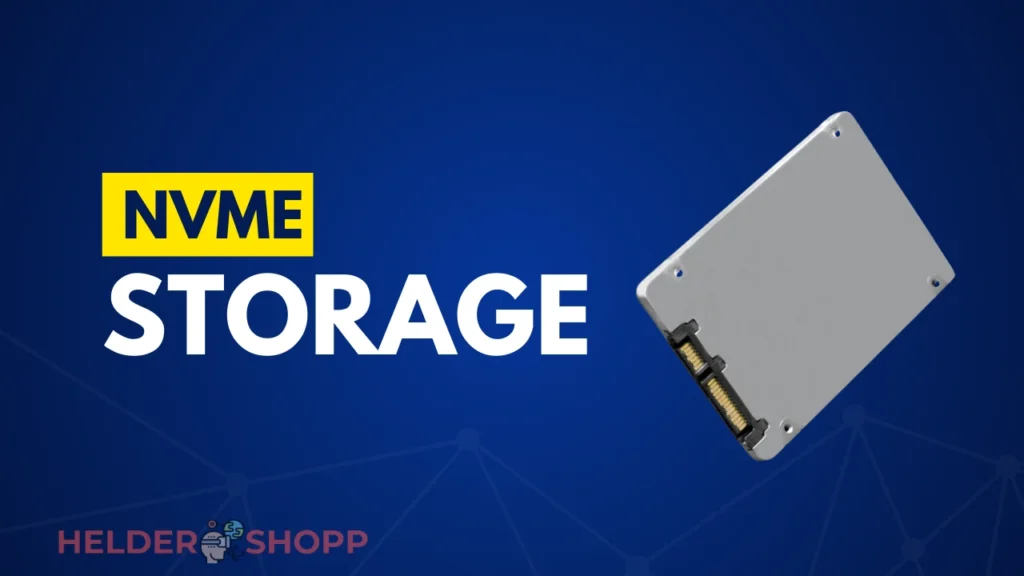NVMe Storage: What Is It and Why You Need It
If you are looking for a fast and reliable way to store your data, you may have heard of NVMe storage. NVMe stands for Non-Volatile Memory Express, and it is a new standard for connecting solid-state drives (SSDs) to your computer.
NVMe storage offers many advantages over traditional SATA or HDD storage, such as faster speed, lower latency, higher capacity, and lower power consumption.
In this article, we will explain what NVMe storage is, how it works, and why you should consider upgrading to it.

Table of Contents
What is NVMe Storage?
NVMe storage is a type of SSD that uses the PCIe interface to communicate with your computer. PCIe, or Peripheral Component Interconnect Express, is a high-speed serial bus that connects various components to your motherboard, such as graphics cards, sound cards, and network cards. PCIe has multiple lanes, each of which can transfer data at up to 16 GB/s. NVMe storage uses four PCIe lanes, which means it can achieve speeds of up to 64 GB/s.
NVMe storage is designed to take advantage of the features and capabilities of SSDs, which are different from hard disk drives (HDDs). SSDs use flash memory to store data, which means they have no moving parts and can access data much faster than HDDs.
HDDs use magnetic platters and spinning disks to store data, which means they have mechanical limitations and can suffer from fragmentation and wear and tear. SSDs also consume less power and generate less heat than HDDs, which makes them more efficient and durable.
NVMe storage is also optimized for parallelism, which means it can handle multiple requests at the same time. NVMe storage has multiple queues and commands, which allow it to process data more efficiently and reduce bottlenecks. NVMe storage also supports features such as trim, which helps to maintain the performance and lifespan of SSDs by deleting unused data blocks.
More:
Dell Pro KM5221W: A Wireless Keyboard and Mouse Combo for Productivity and Comfort
NVIDIA 5000: The Next-Gen GPU for Gen AI, Content Creation, and Data Science
How does NVMe Storage Work?
NVMe storage works by using a protocol that is specifically designed for SSDs. A protocol is a set of rules and standards that govern how devices communicate with each other. The protocol that NVMe storage uses is called NVMe, or Non-Volatile Memory Express. NVMe is a protocol that is based on PCIe, but it is tailored for SSDs and their characteristics.
NVMe storage works by sending and receiving commands and data through the PCIe interface. The commands and data are organized into structures called submission queues and completion queues, which are located in the host memory and the SSD controller. The submission queues contain the commands that the host wants to send to the SSD, and the completion queues contain the responses that the SSD sends back to the host. The host and the SSD use a mechanism called doorbells to notify each other when there are new commands or responses in the queues.
NVMe storage works by using multiple queues and commands, which allow it to handle more requests and data than SATA or HDD storage. NVMe storage can support up to 64,000 queues and 64,000 commands per queue, which means it can process up to 4 billion commands at the same time. SATA or HDD storage can only support one queue and 32 commands per queue, which means they can only process up to 32 commands at the same time.
NVMe storage works by using a streamlined and efficient protocol, which reduces the overhead and latency of data transfer. Overhead is the amount of extra data or processing that is required to perform a task, and latency is the amount of time that it takes to perform a task. NVMe storage has a simpler and more direct command set than SATA or HDD storage, which means it can execute commands faster and with less data. NVMe storage also has a lower latency than SATA or HDD storage, which means it can respond to requests faster and with less delay.

Why You Need NVMe Storage?
NVMe storage is a great option for anyone who wants to improve the performance and reliability of their data storage. NVMe storage offers many benefits over SATA or HDD storage, such as:
- Faster speed: NVMe storage can achieve speeds of up to 64 GB/s, which is much faster than SATA (6 GB/s) or HDD (150 MB/s). This means you can boot your computer, load your applications, and transfer your files faster and more smoothly.
- Lower latency: NVMe storage can respond to requests in microseconds, which is much lower than SATA (milliseconds) or HDD (milliseconds). This means you can access your data faster and with less lag or stuttering.
- Higher capacity: NVMe storage can support up to 16 TB of storage, which is much higher than SATA (4 TB) or HDD (10 TB). This means you can store more data and files on your device, without compromising the speed or performance.
- Lower power consumption: NVMe storage can consume as low as 2.5 W of power, which is much lower than SATA (3.3 W) or HDD (6.8 W). This means you can save energy and extend the battery life of your device, especially if you are using a laptop or a mobile device.
- Higher durability: NVMe storage can withstand shocks, vibrations, and temperatures better than SATA or HDD storage, which means they are less likely to fail or get damaged. NVMe storage also has a longer lifespan than SATA or HDD storage, which means they can last longer and retain their performance.
Conclusion
NVMe storage is a new and advanced type of SSD that uses the PCIe interface and the NVMe protocol to connect to your computer.
NVMe storage offers faster speed, lower latency, higher capacity, lower power consumption, and higher durability than SATA or HDD storage, which makes it ideal for gaming, creative work, and data-intensive tasks.
NVMe storage is one of the best types of storage in the market, and it is definitely worth considering if you are looking for a new and improved way to store your data.

